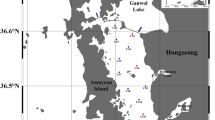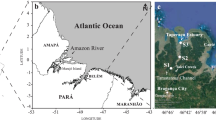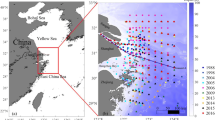Abstract
In the low-salinity area of many macrotidal estuaries, through the combination of tidal pumping and estuarine circulation, an estuarine turbidity maximum (ETM) develops providing favorable conditions for various organisms. To investigate ecological roles of the ETM in East Asian estuaries, we conducted seasonal observations in the Geum (or Keum) River estuary, one of the representative macrotidal estuaries flowing into the Yellow Sea, from 2007 to 2008. The estuary was frequently filled with high-salinity (>10 PSU) and low-turbidity (<100 NTU) water under small or no freshwater discharge from a dam (ca. 8 km upstream from the river mouth). Brackish water was, however, completely pushed out of the estuary within a few hours after an intensive discharge in summer. Chlorophyll a (up to 50 µg l−1) and pheophytin (up to 80 µg l−1) were concentrated in a low-salinity (<1 PSU) and high-turbidity (up to 1000 NTU) area, indicating that the intensive discharge transported both living phytoplankton and resuspended detritus into the area. In contrast, a phytoplankton bloom (chlorophyll a, up to 100 µg l−1) was observed at low salinities under little discharge in winter. The present study demonstrated an absence of the ETM suitable for estuarine-dependent organisms from the present Geum River estuary, indicating potential importance of adequate control of freshwater discharge for the formation and maintenance of the ETM.





Similar content being viewed by others
References
Cifuentes LA, Sharp JH, Fogel ML (1988) Stable carbon and nitrogen isotope biogeochemistry in the Delaware estuary. Limnol Oceanogr 33:1102–1115
Dauvin JC, Dodson JJ (1990) Relationship between feeding incidence and vertical and longitudinal distribution of rainbow smelt larvae (Osmerus mordax) in a turbid well-mixed estuary. Mar Ecol Prog Ser 60:1–12
De Brabandere L, Dehairs F, Van Damme S, Brion N, Meire P, Daro N (2002) δ15N and δ13C dynamics of suspended organic matter in freshwater and brackish waters of the Scheldt estuary. J Sea Res 48:1–15
Fry B, Sherr EB (1984) δ13C measurements as indicators of carbon flow in marine and freshwater ecosystems. Contrib Mar Sci 27:13–47
Fry B, Wainright SC (1991) Diatom sources of 13C-rich carbon in marine food webs. Mar Ecol Prog Ser 76:149–157
Ha K, Kim HW, Joo GJ (1998) The phytoplankton succession in the lower part of hypertrophic Nakdong River (Mulgum), South Korea. Hydrobiologia 370:217–227
Ha K, Jang MH, Joo GJ (2002) Spatial and temporal dynamics of phytoplankton communities along a regulated river system, the Nakdong River, Korea. Hydrobiologia 470:235–245
Ha K, Jang MH, Joo GJ (2003) Winter Stephanodiscus bloom development in the Nakdong River regulated by estuary dam and tributaries. Hydrobiologia 506:221–227
Hibino M, Ueda H, Tanaka M (1999) Feeding habits of Japanese temperate bass and copepod community in the Chikugo River estuary, Ariake Sea, Japan (in Japanese). Nippon Suisan Gakkaishi 65:1062–1068
Hibino M, Ohta T, Kinoshita I, Tanaka M (2002) Fish larvae and juveniles occurring in the littoral zone of a tidal flat, in the bottom of Ariake Bay (in Japanese). Jpn J Ichthyol 49:109–120
Hibino M, Ohta T, Isoda T, Nakayama K, Tanaka M (2006) Diel and tidal changes in the distribution and feeding habits of Japanese temperate bass Lateolabrax japonicus juveniles in the surf zone of Ariake Bay. Ichthyol Res 53:129–136
Islam MS, Hibino M, Tanaka M (2006a) Distribution and diets of larval and juvenile fishes: Influence of salinity gradient and turbidity maximum in a temperate estuary in upper Ariake Bay, Japan. Estuar Coast Shelf Sci 68:62–74
Islam MS, Ueda H, Tanaka M (2006b) Spatial and seasonal variations in copepod communities related to turbidity maximum along the Chikugo estuarine gradient in the upper Ariake Bay, Japan. Estuar Coast Shelf Sci 68:113–126
Islam MS, Hibino M, Tanaka M (2007) Distribution and diet of the roughskin sculpin, Trachidermus fasciatus, larvae and juveniles in the Chikugo River estuary, Ariake Bay, Japan. Ichthyol Res 54:160–167
Japan Meteorological Agency (1970) Manual on oceanographic observation (in Japanese). The Oceanographic Society of Japan, Tokyo
Kim TI, Choi BH, Lee SW (2006) Hydrodynamics and sedimentation induced by large-scale coastal developments in the Keum River Estuary, Korea. Estuar Coast Shelf Sci 68:515–528
Laprise R, Dodson JJ (1994) Environmental variability as a factor controlling spatial patterns in distribution and species diversity of zooplankton in the St. Lawrence Estuary. Mar Ecol Prog Ser 107:67–81
Lee JY, Lee JL (2007) An analytical study on heavy siltation in the Keum River estuary after construction of a dyke. J Coast Res 50:1147–1151
Meyers PA (1994) Preservation of elemental and isotopic source identification of sedimentary organic matter. Chem Geol 114:289–302
Middelburg JJ, Herman PMJ (2007) Organic matter processing in tidal estuaries. Mar Chem 106:127–147
Murakami T, Isaji C, Kuroda N, Yoshida K, Haga H (1992) Potamoplanktonic diatoms in the Nagara River; flora, population dynamics and influence on water quality. Jpn J Limnol 53:1–12
Murakami T, Isaji C, Kuroda N, Yoshida K, Haga H, Watanabe Y, Saijo Y (1994) Development of potamoplanktonic diatoms in downreaches of Japanese rivers. Jpn J Limnol 55:13–21
Murakami T, Kuroda N, Tanaka T (1998) Effects of a rivermouth barrage on planktonic algal development in the lower Nagara River, central Japan. Jpn J Limnol 59:251–262
North EW, Houde ED (2001) Retention of white perch and striped bass larvae: biological–physical interactions in Chesapeake Bay estuarine turbidity maximum. Estuaries 24:756–769
North EW, Houde ED (2003) Linking ETM physics, zooplankton prey, and fish early-life histories to striped bass Morone saxatilis and white perch M. americana recruitment. Mar Ecol Prog Ser 260:219–236
Ogawa N, Ogura N (1997) Dynamics of particulate organic matter in the Tamagawa estuary and inner Tokyo Bay. Estuar Coast Shelf Sci 44:263–273
Oh SH, Koh CH (1995) Distribution of diatoms in the surficial sediments of the Mangyung-Dongjin tidal flat, west coast of Korea (Eastern Yellow Sea). Mar Biol 122:487–496
Park YA, Kim SC, Choi JH (1986) The distribution and transportation of fine-grained sediments on the inner continental shelf off the Keum River estuary, Korea. Cont Shelf Res 5:499–519
Park YH, Lee KS, Lee HY, Son I, Lee JR (2005) Atlas of Korea. Sung Ji Mun Hwa, Seoul
Redfield AC, Ketchum BH, Richards FA (1963) The influence of organisms on the composition of sea-water. In: Hill MN (ed) The sea: ideas and observations on progress in the study of the seas, vol 2. Wiley, New York, pp 26–77
Sato M, Takita T (2000) Biota and environments in Ariake Sea (in Japanese). In: Sato M (ed) Life in Ariake Sea: biodiversity in tidal flats and estuaries. Kaiyu-sha, Tokyo, pp 10–35
Sato T, Miyajima T, Ogawa H, Umezawa Y, Koike I (2006) Temporal variability of stable carbon and nitrogen isotopic composition of size-fractionated particulate organic matter in the hypertrophic Sumida River Estuary of Tokyo Bay, Japan. Estuar Coast Shelf Sci 68:245–258
Suzuki KW, Sugimoto R, Kasai A, Shoji J, Nakayama K, Tanaka M (2007) Dynamics of particulate organic matter in the estuarine turbidity maximum of the Chikugo River, Ariake Sea, in spring (in Japanese). Bull Jpn Soc Fish Oceanogr 71:190–198
Suzuki KW, Kasai A, Ohta T, Nakayama K, Tanaka M (2008a) Migration of Japanese temperate bass (Lateolabrax japonicus) juveniles within the Chikugo River estuary revealed by δ13C analysis. Mar Ecol Prog Ser 358:245–256
Suzuki KW, Kasai A, Isoda T, Nakayama K, Tanaka M (2008b) Distinctive stable isotope ratios in important zooplankton species in relation to salinity gradients: potential tracer of fish migration. Estuar Coast Shelf Sci 78:541–550
Suzuki KW, Sugimoto R, Kasai A, Nakayama K, Tanaka M (2009a) Dynamics of particulate organic matter in the estuarine turbidity maximum of the Chikugo River, Ariake Sea, in summer: influence of the fluctuation of freshwater discharge (in Japanese). Bull Jpn Soc Fish Oceanogr 73:149–160
Suzuki KW, Nakayama K, Tanaka M (2009b) Horizontal distribution and population dynamics of the dominant mysid Hyperacanthomysis longirostris along a temperate macrotidal estuary (Chikugo River estuary, Japan). Estuar Coast Shelf Sci 83:516–528
Takahashi K, Wada E, Sakamoto M (1991) Relationship between carbon isotope discrimination and the specific growth rate of green alga Chlamydomonas reinhardtii. Jpn J Limnol 52:105–112
Takahashi K, Wada E, Sakamoto M (1992) Carbon isotope ratio and photosynthetic activity of phytoplankton in the eutrophic Mikawa Bay, Japan. Ecol Res 7:355–361
Uncles RJ, Stephens JA, Smith RE (2002) The dependence of estuarine turbidity on tidal intrusion length, tidal range and residence time. Cont Shelf Res 22:1835–1856
Wells JT, Park YA (1992) Observations on shelf and subtidal channel flow: Implications of sediment dispersal seaward of the Keum River estuary, Korea. Estuar Coast Shelf Sci 34:365–379
Acknowledgments
We would like to express our gratitude to Prof. C.-H. Jeong of Research Center for Coastal Environments of Yellow Sea, Inha University, for his kind suggestions for observations. We really appreciate the generosity of the Geum River Flood Control Office of the Ministry of Construction and Transportation, Korea, for supplying detailed data on freshwater discharge. We are also grateful to the captain of the boat and graduate students in the laboratories of Gyeongsang National University and Kyoto University for their assistance with observations. Photosynthetic pigment concentrations were measured at the Laboratory of Aquatic Environmental Microbiology in the Faculty of Agriculture, Kyoto University. Stable isotope ratios were analyzed at the Center for Ecological Research, Kyoto University. This study was supported in part by Grants-In-Aid from the Ministry of Education, Culture, Sports and Science of Japan.
Author information
Authors and Affiliations
Corresponding author
Rights and permissions
About this article
Cite this article
Suzuki, K.W., Gwak, WS., Nakayama, K. et al. Instability of the turbidity maximum in the macrotidal Geum River estuary, western Korea. Limnology 11, 197–205 (2010). https://doi.org/10.1007/s10201-009-0303-7
Received:
Accepted:
Published:
Issue Date:
DOI: https://doi.org/10.1007/s10201-009-0303-7




